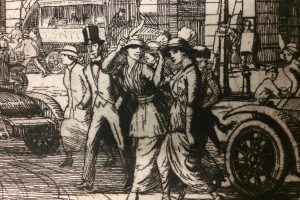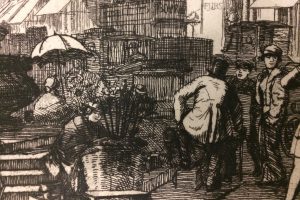Randolph Schwabe, (1885 – 1948), was the son of a Manchester cotton merchant who had emigrated from Germany. He was educated at The Slade Art School after the family moved to London. Schwabe was a draughtsmen, painter and etcher and became the Slade Professor of Fine Art at University College London from 1930 until his death. He served as a war artist in both World Wars, created designs for theatrical productions and illustrated a number of books (Wikipedia).
Researching this etching of Piccadilly ‘Circus Looking North’ suggests it was created in 1927, however, the date following the artist’s signature on the lower right of the picture reads 1913; the earlier date would be in accordance with the style of clothes worn and the vehicles depicted in the print. 1913 was the year following the Titanic disaster and the year before the start of the Great War; the Queen’s grandfather George V was Monarch and Herbert Henry Asquith the Prime Minister; the suffragette Emmeline Pankhurst was sentenced to 3 years in prison and fellow campaigner Emily Davidson lost her life being trampled by the King’s horse at Epsom.
As the title suggests the view is one from Piccadilly Circus looking north along the lower reaches of Regent Street in Central London.

The scene is typical of early evening in the West End, with well-dressed wealthy looking types on their way to the theatre or posh restaurant, whilst others appear to have met under the statue of Eros and are making conversation. In the mid-ground of the scene we notice people scrambling to board the motorised double-decker bus, a new invention, which gradually replaced the Victorian horse-drawn vehicles.

The etching also shows the ever-present divide between the ‘haves’ and the ‘have-nots’, with the fashionable people attracting the envious gaze of others. In the centre of the scene, we can see an older woman selling flowers and nearby is a shoe-shine boy polishing the footwear of a gentleman wearing a top hat.
The etching also shows the ever-present divide between the ‘haves’ and the ‘have-nots’, with the fashionable people attracting the envious gaze of others. In the centre of the scene, we can see an older woman selling flowers and nearby is a shoe-shine boy polishing the footwear of a gentleman wearing a top hat.
Blog written by John Volynchook
Posted on 21 March 2018 under Museum







